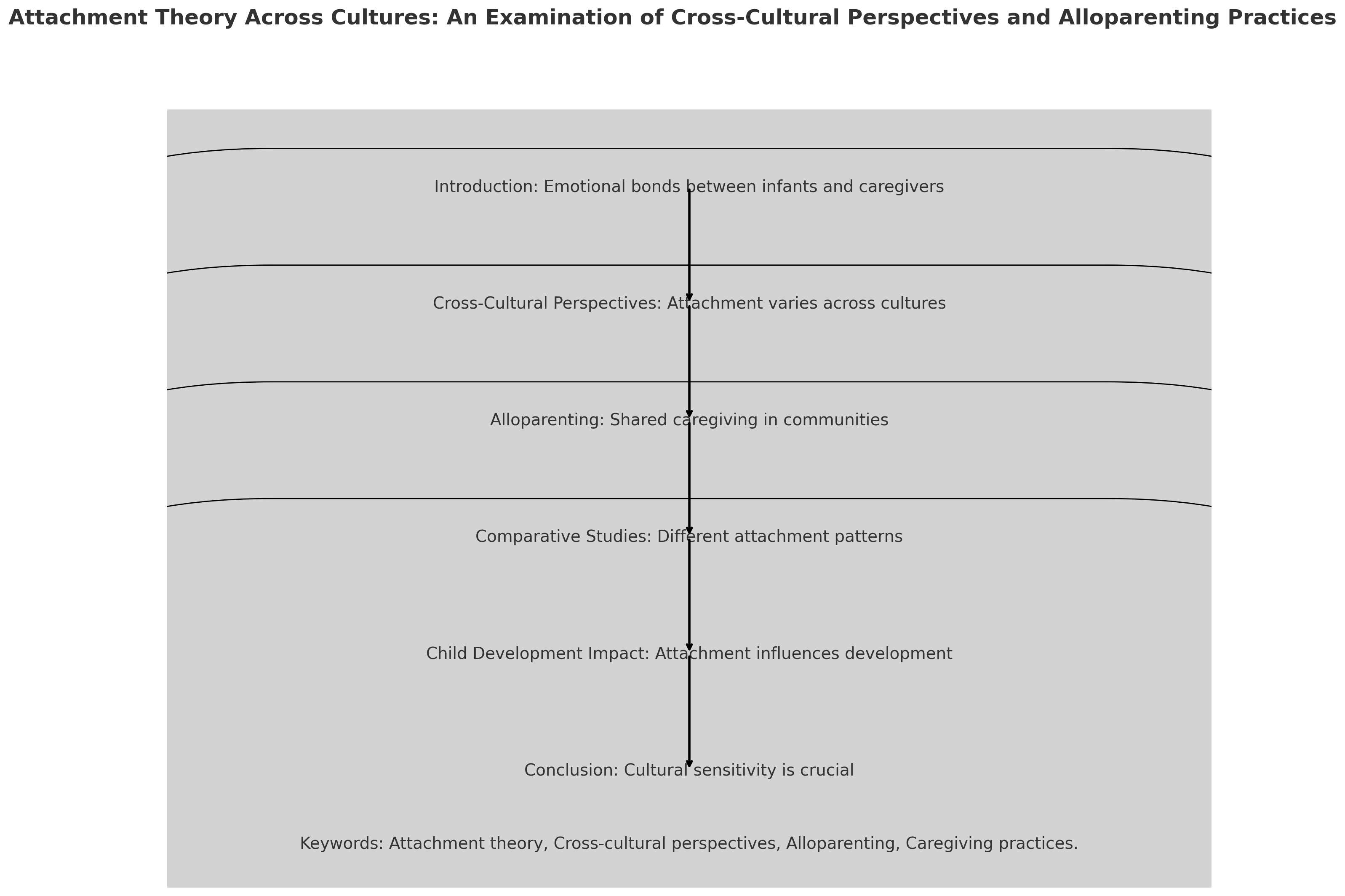Attachment theory across cultures: An examination of cross-cultural perspectives and alloparenting practices (Mini-Review)
DOI:
https://doi.org/10.14295/bjs.v3i8.616Keywords:
attachment theory, cross-cultural perspectives, alloparenting, caregiving practicesAbstract
Attachment theory initially put forth by Bowlby is a basis for comprehending the emergence and importance of emotional bonds between infants and their caretakers. However, contemporary studies have increasingly highlighted the necessity for accounting for cultural contexts in attachment dynamics. This paper aims at investigating all aspects of attachment theory using a cross-cultural perspective to find out how cultural norms and customs influence relationships of attachment. In particular, it is based on an explanation of the concept of alloparenting which implies that caregiving duties are distributed among more than one member in a community. The author compares Western and non-Western child-rearing practices including examples from such societies as Aka foragers located in Africa or Beng people in West Africa among others thereby revealing the wide range of different kinds of relationships formed as attachments by humans. Furthermore, it also probes how this affects child development, family structures, and societal values regarding culture-specific ways that children attach to primary caregivers through understanding themselves as culturally specific and thus not universal. By synthesizing experiential research and speculative platforms, this paper enhances our comprehension of attachment theory in terms of cultural diversity, stressing the significance of including cultural viewpoints in developmental psychology research as well as its everyday use.
References
Ainsworth, M. D. S. (1979). The bowlby-ainsworth attachment theory. Behavioral and Brain Sciences, 2(4), 637-638. https://doi.org/10.1017/s0140525x00075828 DOI: https://doi.org/10.1017/S0140525X00064955
Bakermans-Kranenburg, M. J., van IJzendoorn, M. H., & Kroonenberg, P. M. (2004). Differences in attachment security between African-American and white children: Ethnicity or socio-economic status? Infant Behavior and Development, 27(3), 417-433. https://doi.org/10.1016/j.infbeh.2004.02.002 DOI: https://doi.org/10.1016/j.infbeh.2004.02.002
Bowlby, J. (1988). A secure base. New York, NY: Basic Books.
Bretherton, I. (1985). Attachment theory: Retrospect and prospect. Monographs of the Society for Research in Child Development, 50(1-2), 3-35. https://doi.org/10.2307/3333824 DOI: https://doi.org/10.2307/3333824
Bretherton, I. (1992). The origins of attachment theory: John Bowlby and Mary Ainsworth. Developmental Psychology, 28(5), 759-775. DOI: https://doi.org/10.1037//0012-1649.28.5.759
Gottlieb, A. (2004). The afterlife is where we come from. Chicago, IL: Chicago University Press. DOI: https://doi.org/10.7208/chicago/9780226330631.001.0001
Grossmann, K. E. (1981). German children’s behavior towards their mothers at 12 months and their fathers at 18 months in Ainsworth’s strange situation. International Journal of Behavioral Development, 4(2), 157-181. https://doi.org/10.1177/016502548100400202 DOI: https://doi.org/10.1177/016502548100400202
Hazan, C., & Diamond, L. M. (2000). The place of attachment in human mating. Review of General Psychology, 4(2), 186-204. https://doi.org/10.1037/1089-2680.4.2.186 DOI: https://doi.org/10.1037//1089-2680.4.2.186
Keller, H. (2013). Attachment and culture. Journal of Cross-Cultural Psychology, 44(2), 175-194. https://doi.org/10.1177/0022022112472253 DOI: https://doi.org/10.1177/0022022112472253
Kermoian, R., & Leiderman, P. H. (1986). Infant attachment to mother and child caretaker in an East African community. International Journal of Behavioral Development, 9(4), 455-469. https://elibrary.ru/item.asp?id=7361334 DOI: https://doi.org/10.1177/016502548600900404
Lee, J. W., & Miller, C. (2019). Digital communication and attachment in immigrant families. Journal of Family Communication, 19(3), 227-240. https://doi.org/10.1080/15267431.2019.1625096
Lewis, M. (2005). The child and its family: The social network model. Human Development, 48(1-2), 8-27. https://doi.org/10.1159/000083213 DOI: https://doi.org/10.1159/000083213
Main, M. (1990). Cross-cultural studies of attachment organization: Recent studies, changing methodologies, and the concept of conditional strategies. Human Development, 33(1), 48-61. https://doi.org/10.1159/000276502 DOI: https://doi.org/10.1159/000276502
Martinez, S., Smith, P., & Johnson, L. (2022). Attachment behaviors in digital-native children: Evolution in the context of modern technology. Journal of Child Development, 93(1), 45-58. https://doi.org/10.1111/cdev.13658 DOI: https://doi.org/10.1111/cdev.13658
Maynigo, P. M. (2015). Cultural differences in attachment and emotion: Emotionally focused therapy with intercultural couples. Doctoral dissertation, Rutgers University-Graduate School of Applied and Professional Psychology, The State University of New Jersey.
Meehan, C. L., Quinlan, R., & Malcom, C. D. (2013). Cooperative breeding and maternal energy expenditure among Aka foragers. American Journal of Human Biology, 25(1), 42-57. https://doi.org/10.1002/ajhb.22336 DOI: https://doi.org/10.1002/ajhb.22336
Pietromonaco, P. (2000). Attachment theory as an organizing framework: A view from different levels of analysis. Review of General Psychology, 4(2), 107-110. https://doi.org/10.1037/1089-2680.4.2.107 DOI: https://doi.org/10.1037//1089-2680.4.2.107
Rothbaum, F. (2002). Family systems theory, attachment theory, and culture. Family Process, 41(3), 328-350. https://doi.org/10.1111/j.1545-5300.2002.41305.x DOI: https://doi.org/10.1111/j.1545-5300.2002.41305.x
Smith, A. B., & Lee, S. H. (2020). Cultural variations in attachment and the impact of technology on modern caregiving practices. Journal of Cultural Psychology, 56(4), 377-390. https://doi.org/10.1037/cp0000200
Snyder, R., Shapiro, S., & Treleaven, D. (2012). Attachment theory and mindfulness. Journal of Child and Family Studies, 21, 709-717. https://doi.org/10.1007/s10826-011-9522-8 DOI: https://doi.org/10.1007/s10826-011-9522-8
Tronick, E. Z., Morelli, G. A., & Ivey, P. K. (1992). The Efe forager infant and toddler's pattern of social relationships: Multiple and simultaneous. Developmental Psychology, 28(4), 568-572. https://psycnet.apa.org/doi/10.1037/0012-1649.28.4.568 DOI: https://doi.org/10.1037//0012-1649.28.4.568
Van IJzendoorn, M. H., Bakermans-Kranenburg, M. J., & Sagi-Schwartz, A. (2006). Attachment across diverse sociocultural contexts: The limits of universality. In: Clarke-Stewart, K. A., & Bornstein, M. H. (Eds.), Parenting beliefs, behaviors, and parent-child relations: A cross-cultural perspective, 107-142 p. https://doi.org/10.1037/10128-004 DOI: https://doi.org/10.1037/10128-004
Van IJzendoorn, M. H., & Sagi-Schwartz, A. (2018). Disparities in attachment patterns across different cultures: Sensitive caregiving reconsidered. International Journal of Behavioral Development, 42(5), 589-600. https://doi.org/10.1177/0165025418797105

Downloads
Published
How to Cite
Issue
Section
License
Copyright (c) 2024 Myrto Patagia Bakaraki, Theofanis Dourbois, Alexandra Kosiva

This work is licensed under a Creative Commons Attribution 4.0 International License.
Authors who publish with this journal agree to the following terms:
1) Authors retain copyright and grant the journal right of first publication with the work simultaneously licensed under a Creative Commons Attribution License that allows others to share the work with an acknowledgement of the work's authorship and initial publication in this journal.
2) Authors are able to enter into separate, additional contractual arrangements for the non-exclusive distribution of the journal's published version of the work (e.g., post it to an institutional repository or publish it in a book), with an acknowledgement of its initial publication in this journal.
3) Authors are permitted and encouraged to post their work online (e.g., in institutional repositories or on their website) prior to and during the submission process, as it can lead to productive exchanges, as well as earlier and greater citation of published work.



